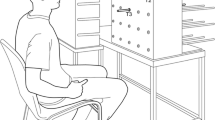Abstract
Animal studies suggest that the basal ganglia (BG) provide internal cues to trigger submovements in a movement sequence, with Parkinson's disease (PD) involving a deficiency in this cueing mechanism. However, it is not clear why defective internal cues can produce slow movements, or the extent to which slow movements are indeed the basic movement abnormality or are perhaps a compensatory mechanism for some other primary deficit. In this study we examined a number of the kinematic indices of matched fast movements between PD patients and age-matched controls, performed with and without reductions in visual cues for guidance, in order to delineate the relationship between the internal cue and the kinematic characteristics of these movements. Fourteen patients with PD, and their matched controls, used an electronic pen, which sampled pen-tip position at 200 Hz, and performed a se quence of drawing movements to nine targets upon a WACOM SD 420 graphics tablet. Subjects were trained to perform the movement sequence at a fast speed and were then required to perform the same movement at the same speed with reduced visual cues. Kinematic analysis indicated that, when visual cues were reduced, movements of PD patients became spatially and temporally unstable as they were progressively performed down the sequence. The instability was associated with an abnormal force profile, increase in peak movement velocity and target overshoot, which became additive as the submovements progressed. We suggest that defective cue production is the basic deficit in parkinsonian hypokinesia. The defective cue leads to problems synchronising preparatory activity, which then results in abnormalities in movement forces which are characterised by unpredictable and inaccurate movement endpoints. When movements are strung together in a sequence the inaccuracy is additive leading to motor in stability.
Similar content being viewed by others
References
Baker JR, Davey NJ, Ellaway PH, Friedland CL (1992) Shortterm synchrony of motor unit discharge during weak isometric contraction in Parkinson's disease. Brain 115:137–154
Bock O, Arnold K (1992) Motor control prior to movement onset: preparatory mechanisms for pointing at visual targets. Exp Brain Res 90:209–216
Brotchie P, Iansek R, Horne MK (1991a) Motor function of the monkey globus pallidus: neuronal discharge and parameters of movement. Brain 114:1667–1683
Brotchie P, Iansek R, Horne MK (1991b) The motor function of the monkey globus pallidus: cognitive aspects of movement and phasic neuronal activity. Brain 114:1685–1702
Georgiou N, Iansek R, Bradshaw JL, Phillips JG, Mattingley JB, Bradshaw JA (1993) An evaluation of the role of internal cues in the pathogenesis of parkinsonian hypokinesia. Brain 116:1575–1587
Glickstein M, Stein J (1991) Paradoxical movement in Parkinson's disease. Trends Neurosci 14:480–482
Hallett M, Khoshbin S (1980) A physiological mechanism of bradykinesia. Brain 103:301–314
Hogan N, Flash T (1987) Moving gracefully: quantitative theories of motor coordination. Trends Neurosci 10:170–174
Isenberg C, Conrad B (1994) Kinematic properties of slow arm movements in Parkinson's disease. J Neurol 241:323–330
Kokmen E, Smith GE, Peterson RC, Tangalos E, Ivnick RC (1991) The short test of mental status: correlations with stan dardized psychometric testing. Arch Neurol 48:725–728
Meyer DE, Smith JEK, Kornblum S, Abrams RA, Wright CE (1991) Speed-accuracy tradeoffs in aimed movements: toward a theory of rapid voluntary action. In: Jeannerod M (ed) Attention and performance XIII. Erlbaum, Hillsdale, N.J., pp 173–223
Muller F, Abbs JH (1990) Precision grip in Parkinsonian patients. Adv Neurol 53:191–195
Nagasaki H (1989) Asymmetric velocity and acceleration profiles of human arm movements. Exp Brain Res 74:319–326
Nagasaki H, Nakumura R (1982) Rhythm formation and its disturbances — a study based upon periodic response of a motor output system. J Hum Ergology 11:127–142
Nakamura R, Nagasaki H, Narabayashi H (1978) Disturbances of rhythm formation in patients with Parkinson's disease. 1. Characteristics of tapping response to the periodic signals. Percept Mot Skills 46:63–75
Phillips J, Stelmach G, Teasdale N (1991) What can indices of handwriting quality tell us about Parkinsonian handwriting? Hum Mov Sci 10:301–314
Roland PE, Meyer E, Shibasaki T, Yamamoto YL, Thompson CJ (1982) Regional cerebral blood flow changes in cortex and basal ganglia during voluntary movements in normal human volunteers. J Neurophysiol 48:467–480
Schell GR, Strick PL (1984) The origin of thalamic inputs to the arcuate premotor and supplementary motor areas. J Neurosci 4:539–560
Selby G (1990) Clinical features. In: Stern GM (ed) Parkinson's disease. Chapman and Hall, London, pp 333–388
Smyth MM, Wing AM (1984) The psychology of human movement. Academic, London
Stelmach GE, Worringham CJ (1988) The preparation and production of isometric force in Parkinson's disease. Neuropsychologia 26:93–103
Stelmach GE, Teasdale N, Phillips J, Worringham CJ (1989) Force production characteristics in Parkinson's disease. Exp Brain Res 76:165–172
Tanji J, Kurata K (1985) Contrasting neuronal activity in supplementary and precentral motor cortex of monkeys. I. Responses to instructions determining motor responses to forthcoming signals of different modalities. J Neurophysiol 53:129–141
Teasdale N, Stelmach GE (1988) Movement disorders: the importance of the movement context. J Mot Behav 20:186–191
Teasdale N, Phillips J, Stelmach GE (1990) Temporal movement control in patients with Parkinson's disease. J Neurol Neurosurg Psychiatr 53:862–868
Webster DD (1968) Critical analysis of the disability in Parkinson's disease. Mod Treatment 5:257–282
Author information
Authors and Affiliations
Rights and permissions
About this article
Cite this article
Martin, K.E., Phillips, J.G., Iansek, R. et al. Inaccuracy and instability of sequential movements in Parkinson's disease. Exp Brain Res 102, 131–140 (1994). https://doi.org/10.1007/BF00232445
Received:
Accepted:
Issue Date:
DOI: https://doi.org/10.1007/BF00232445




